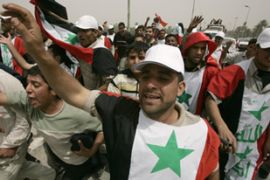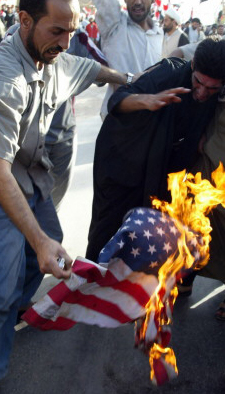Protests mark Iraq anniversary
Shia protesters call for end to US occupation, four years after Baghdad’s fall.

Angry chants
Hundreds of banners saying “Down with Bush, Down with America” were carried by protesters as Iraqi police and soldiers guarded checkpoints in and around Najaf and Kufa.
| Timeline | ||
|
Many people, draped in Iraqi flags, set US flags ablaze and some trampled on and struck US and Israeli flags painted on the ground with their shoes, an act considered one of the worst insults in Arab culture.
“In four years of occupation, our sons have been killed and women made widows,” cried Ahmed al-Mayahie, 39, a Shia from the southern city of Basra.
“The occupier raised slogans saying Iraq is free, Iraq is liberated. What freedom? What liberation? There is nothing but destruction. We do not want their liberation and their presence. We tell them to get out of our land.”
Falah Hassan Shanshil, an MP from al-Sadr’s parliamentary bloc, said: “This crowd has come to reject the American occupation and demand its withdrawal.”
It was not known whether al-Sadr himself would address the crowds.
In the capital Baghdad, security was tight.
A 24-hour vehicle curfew was in place and all Baghdad‘s key roads and bridges were deserted as people remained indoors for fear of attacks.
| Your Views |
|
“The chances of success [in Iraq] are essentially zero because the Iraqi people have no voice” Non Sequitur, Cadiz, Spain |
Residents of Baghdad who welcomed the invading US troops on April 9, 2003, now blame the rampant bloodshed and chaos on what even some of the country’s most senior leaders brand an unwanted US-led occupation.
Al-Sadr has been in hiding since the launch of a security crackdown in Baghdad aimed largely at reining in his militiamen, who are accused of killing Sunni Arabs.
The US military has said he is in Iran but his aides deny the claims.
The preacher, who launched two bloody rebellions against US forces in 2004, is known for his anti-US stance and has emerged as a powerful force in the present Shia-led Iraqi government.
His political bloc has 32 representatives in the 275-member parliament and six cabinet ministers in the embattled government.
Al-Sadr call
 |
| Supporters of al-Sadr burnt US flags [AFP] |
On Sunday, al-Sadr reiterated his call to unite against the Americans and end fighting between his militiamen and security forces in the central city of Diwaniya.
US and Iraqi soldiers have been clashing with his militiamen in Diwaniya since Friday.
Calling for unity against US troops, al-Sadr urged local forces not to support the “occupier because it is your enemy”.
“Iraq has had enough bloodshed. The occupation forces led by the biggest evil, America, is working to sow dissent either directly or through its agents.”
On April 9, 2003, US troops pulled down the giant statue of Saddam by a rope around the neck, in a premonition of his hanging in December for crimes against humanity.
But gone is the praise for George Bush, the US president, for toppling the regime.
Angry chants of “Down with Bush” are a frequent background to brutal Shia and Sunni sectarian strife.
About 80,000 US and Iraqi troops are now patrolling the capital’s streets.
Since March 20, 2003, the day the war began, tens of thousands of Iraqis have died in attacks and sectarian violence.
The four years have also been brutal for the US forces in Iraq.
On Monday, the military reported the deaths of six more soldiers in a series of attacks, taking its toll for the month alone to 27 and 3,275 since the invasion, according to an AFP news agency count based on Pentagon figures.
